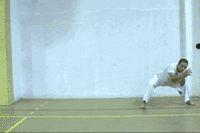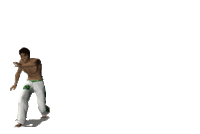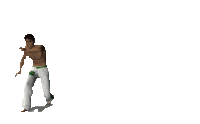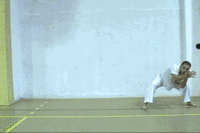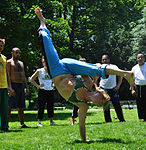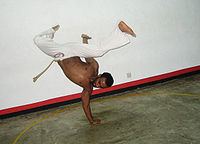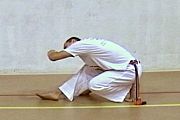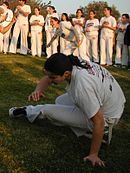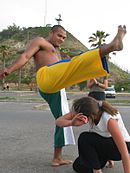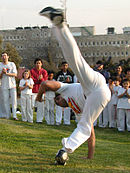- List of capoeira techniques
-
This is a list of techniques used in capoeira. Capoeira has a variety of different techniques that make use of the hands, feet, legs, arms and head. Both kicks, punches and takedowns are among the offensive movements, but the emphasis is normally on kicking. Because of the appearance of many techniques, they are often mistaken for dancing or acrobatic maneuvers. However, while capoeira has some quite impressive, acrobatic signature moves, many of the basic techniques in capoeira are similar to those found in other martial arts.
Please be aware that different groups may use different names for the same techniques, or use the same name for different techniques.
Contents
Movement
Ginga
The ginga (pronounced jinga; literally: rocking back and forth; to swing) is the fundamental movement in capoeira. Capoeira Angola and capoeira regional have distinctive forms of this movement. In Angola, ginga is a very free and individualistic, while in regional the ginga has a more structured look. In most Regional schools, the ginga is learned the same way until the aluno advances to a certain level and begins to develop their own style of using it.[1] Both are accomplished by maintaining both feet approximately shoulder-width apart and then moving one foot backwards and then back to the base, describing a triangular 'step' on the ground.
Ginga movement is done to prepare the body for other movements such as evading, feinting and even delivering attacks. The ginga keeps a capoeirista in constant motion, making them a frustrating target for a forward-advancing opponent,.[1] It also provides a synchronization of the arm movement in such a way as to either avoid and slip under attacks. The torso and legs are usually low to assist in evading high kicks and balance. As there is not a static position to the ginga its speed is usually determined by the toque or rhythm that is played by the bateria. The Ginga is also capoeira's most recognized movement. Very few martial arts employ a constant rhythmic movement that matches the ginga. One of the few exceptions would be Korea's own taekkyeon. The Ginga movement continually rebuilds and stores the torque power that the Capoeirista may use in a strike. One training technique of pairing students and having one run across the training hall with arms free as the other student acts like a weight, wrapping their arms around the runners waist and being immobile forces the runner to pump their arms and twist side to side. This demonstrates the torque that can be achieved and what can be gained in the sway, that makes it less languid . It is used in Capoeira so that strikes from out of peripheral vision are not just glancing blows.
Cadeira
The cadeira is the position in the ginga when both legs are squared off. This makes it the actual base of the ginga. Depending on how the capoeira academy teaches, the cadeira is generally a low position similar to one that a shortstop adopts right before stopping a ground ball. One arm is protecting the face while the other is extended out protecting the other side. Since it is essentially a low squat with the torso slightly bent at the waist, most of the core muscles are engaged to keep balance. All attack, movements, and escapes can flow seamlessly from this position including balança, au, queda de rins, martelo, resistência, and many others. An alternate name for cadeira is 'parlelo'.
Aú
An aú is the capoeira term for what is more generally called a cartwheel. It differs a bit from the traditional cartwheel. An aú, in its base form, is performed very slowly, with arms and legs bent in order to keep a low target profile. Also the back can be curved in order to perform a kicking maneuver. Since a capoeira player always risks being kicked while upside down, capoeira players always watch their opponent instead of the ground. Capoeira players can incorporate attacks from the au. These include an upside down kick known as an Aú Malandro or Aú Batido. Players sometime pause midway during an aú holding it for a handstand position, from which they can execute a wide variety of moves. The aú variants are:
- Aú Aberto—From esquiva, the free arm reaches in an arc over the head in the direction of motion. The leg extended furthest from the body leaves the ground first, kicking off and providing momentum. Then the reaching hand is placed on the far side of the body. Bending the arms at the elbows supports weight as both legs pass over the body fully extended. While inverted, the body should be opened and entirely extended. One foot touches the ground then the other. The arms must be lifted for protection as soon as they are no longer supporting weight.
- Aú Batido—The aú batido is an aú variation where a practitioner does a handstand, followed by a twist with the hips and a split, performing a downward martelo. During the kick, one arm is protecting the face while the other one is obviously supporting the body. Aú batido literally means "broken cartwheel". This movement is a defensive move, used when attempting to perform a cartwheel and the opponent attacks, generally with a cabeçada, a headbutt, the aú batido takes place, attacking the opponent by surprise before the attack is executed. The aú batido is sometimes also used in doubt or simply as a trick move. This move is also performed in tricking, and for quality, it is also used often in breakdancing where it is known as the L-kick. Names used in different schools may also include Beija Flor (Humming Bird, literally Flower Kiss(er)), Leque (Fan), Aú Québrado (also "broken cartwheel"), Aú Malandro(wily cartwheel), Aú Amazonas (Amazon cartwheel) or Amazonica.
- Aú Batendo-A similar technique, except that the hands generally stay on the ground and the cartwheel is not stopped during the kick, but rather continues over.
- Aú Fechado—From esquiva or negativa, the free arm reaches in an arc over the head in the direction of motion. The leg extended furthest from the body leaves the ground first, kicking off and providing momentum. Then the reaching hand is placed on the far side of the body. Bending the arms at the elbows supports weight as both legs pass bent in front of and slightly over the body. While inverted, the body should be closed and maximally protected. One foot touches the ground and then the other. The last step is return to esquiva.
- Aú sem Mão—An aú performed without hands in the same manner as the aerial cartwheel. Can be used to stylishly avoid sweeps such as a rasteira or banda.
Aú variants Basic Aú.Aú Aberto (open aú).Aú variation Aú fechado.Aú Fechado (closed aú).Aúzinho.Aú Batido (broken aú).Aú Batido (broken aú)Balança
A series of side to side feints done with the torso to deceive the opponent, throw off their timing, and make it harder for them to track the centerline. In a similar manner as a speedskater, the bodyweight is shifted from one leg to the other in a slight lateral hopping/sliding motion while the arms move in a similar fashion as they do during the ginga. The balança is usually done from the forward ginga and is also known as the Cavalo. As with other movements in capoeira, all types of kicks, handstrikes, or headbutts can be executed unexpectedly from the movement.
Bananeira
The bananeira is a handstand in capoeira that derives its name from the banana trees of Brazil. The hands are spread at least shoulder-width apart and the legs are usually together over the capoerista's head. Other variations include having the legs split apart to the side or front. One outlying difference the bananeira has in capoeira is that the face and eyes of the capoeirista are towards the other player; not the ground. While in Bananeira, the feet can be used to defend as well as attack. The bananeira's other uses can be to take a quick break and observe the other player, draw an opponent in to a trap, or in the case of contemporary regional schools, show off balance and strength as a floreio. The bananeira is thought to have originated from the use of the handstand by an Nganga (Bantu healers and spiritual leaders) by showing their spiritual connection to the ancestors who walk on their hands in the spirit world.
Macaco
The macaco is similar to a back handspring with the exception of starting with one hand planted behind the capoeirista and the initial movement starting from a low crouch. The macaco begins by lowering the body down into a low crouch and placing one hand on the floor directly behind the back making contact with the ground. The other hand is thrown over the body while jumping off with both feet to launch the hips straight over the head. This back sweeping movement mirrors the motion that a swimmer adopts when performing a backstroke. As the capoeirista passes into a handstand position, the second hand is placed onto the ground before bringing the first foot makes contact with the ground. The macaco shares visual similarities with the valdez. Variations can include beginning and finishing with the first arm and/or landing with both feet simultaneously. The move is commonly known as the jump of the monkey as the word Macaco literally translates to monkey.
- Macaquinho
This movement is very similar to the macaco with the exception being that it is lower and less explosive. The knees are in a more forward bent position while one arm is placed directly behind the balls of the feet. Instead of jumping as with the macaco, the capoeirista lowers his/her external oblique onto his elbow and brings his other arm and legs over. The macaquinho, which means little monkey, is a combination of a macaco and queda de rins.
- Macaco em Pé
This is a macaco that is done without a hop or crouch. The macaco em pé resembles the combined motions of a back walkover and a cartwheel. Instead of crouching and jumping, the capoeirista falls backwards onto one arm while bending his back and allowing his hips to go over his head while moving into a standard macaco motion.
- Macaco Lateral
This is also known as a Xango. It is a standard back handspring. Instead of placing one hand on the ground and flipping, an abrubt leap is made backwards in an arch while extending the hands over the head.
Negativa
Meaning "negative," the negativa is used to negate an attack by going low to the ground on one's side, with the leg closest to the ground tucked to the chest, the other extended, supporting one's body weight with the hand , with the upper arm in a location to protect the face. Negativa can also be performed in a lower stance with the stomach parallel to the ground. The negativa is also used as a sweep. If the other capoeirista is delivering a standing kick that leaves them with only one supporting leg, the extended leg can be used to hook behind that supporting leg and sweep it. This takedown is known as a negativa derrubando.
Rabo-de-Arraia
Literally translates to "stingray's tail." This is a popular name given to different capoeira movements at different times and capoeira schools. There are more than 7 techniques that were at some point in time called "Rabo de Arraia". Today, it mostly refers to the Meia lua de Compasso in Capoeira Regional schools.
Rolê
Rolê: This 'rolling' motion is - together with the Ginga and the Au - the basic method of moving around in the Roda. This move can be performed from Ginga or from most of the esquivas. It is essentially a spin to one side by the capoeirista while remaining low to the ground and always watching the other player. One of the hallmarks of the move is that during the part where the back is facing the opponent, eye contact is maintained via looking between the legs to watch for an attack. The rolê can end easily in Ginga, Negativa, or various esquivas. The Rolê de Cabeça variation is performed by placing the head on the ground in the middle of the rolê so as to be able to transition into various headstand techniques.
Troca De Pé
Literally Change of Foot, From a Negativa position with the leg extended, a slight hop during which the extended leg becomes the support leg and the guard arm becomes the support arm and vice versa.
Ponte
The ponte is a bridge with the stomach facing upward and the hands and feet pushing to keep the back arched and off the floor. Most learn to roll into a ponte by turning their legs and hips around first and then inverting into a bridge. The capoeirista can then roll out into a cocorinha, queda de rins, or resistincia for a stylish entrance into a roda. The ponte also doubles as a last resort esquiva although that depends on the player's skill level, style, and speed of the game. Another interesting fact is that Mestre Bimba would give a potential student (aluno) a series of tests before actually teaching them at his academy. One of the tests was a measure of the applicant's natural ability to hold a bridge
Queda de Rins
The queda de rins (fall on the kidneys) can be used as an esquiva or a launching point for a technique. It involves supporting the torso with the inside elbow and the head, often with the knees resting on the supporting elbow. The head is usually the lowest with the feet and at the highest in a rough 45° angle. The legs themselves may be together, tuck, split depending on the position.
Defensive movements
Cocorinha
One of the simplest defense movements. With the feet flat on the ground the player squats with the knees to the chest so as to close the body and covers the side of the torso and head with one hand while the other is flat and to the side for support.
Another variation of this involves squatting with the balls of the feet on the ground and arms crossed in front and above the face.
Esquiva
Literally escape or dodge. Many forms exist but all involve moving the head and torso out of the way of an attack. Esquivas distinguish capoeira from many other martial arts for the simple fact of going along with flow of the attack and releasing an equal or more devastating attack. Many of the attacks in capoeira are fully committed kicks that would cause more injury blocking them instead of dodging them. Blocking attacks upset and imbalance the flow of the game making esquivas more common in rodas. Blocks do sometimes occur when one player is so caught off guard that they are used instinctively. The most common situations being defenses against hand attacks.
- Esquiva de Baixa
Also known as Esquiva de Frente."Low dodge", this has the looks of an extremely low ginga. The rear leg and foot are exaggerated and placed even farther back to bring the hips lower to the ground. The torso is bent forward bringing the head even lower. If the left foot is back then the right hand is placed on the floor; the left hand is used to guard the face and head.
- Esquiva Lateral
"Side escape" or side dodge. It is executed while the feet are in a parallel position. The escape is simply bringing the torso down and to the left or right (depending on the direction of the other player's kick) and reaching the hand over the head The hand can also be placed in front of the face for protection. Some academies will place the hand that is not guarding onto the floor to get even lower.
- Esquiva Diagonal
This is a dodge that simultaneously dodges and advances forward. Instead of going straight down under an attack or off to the side like in the esquiva lateral or esquiva de frente, the capoeirista steps diagonally of to the left or right of the attack. He/she places his front foot in a perpendicular position to his back foot and crouches down at the knees in a low lunge. The left or right arm comes up to protect the face depending on the direction of the attack while the other arm maintains the body’s balance. This is a quite useful esquiva because many counterattacks are available to the player from this position which can include martelos, ganchos, or vingativas saving valuable time.
Queda de Quatro
Literally fall of four. Simply fall backwards into a crab-walk position, often followed by scurrying backwards and away from the opponent.
Queda de Tres
Falling back onto the wrists and one leg. The other leg is up because this position is often "forced" when the player is taken down from being supported on a single leg. For example: sweeping the base leg of armada leads the fallen player to, hopefully, end in this position.
Resistência
This is very similar to its sister, the negativa. However, instead of resting on the entire sole of the foot, the ball of the foot supports a majority of the weight with the arm on the opposing side helping. The fingers on the supporting hand are spread out flat to protect the wrist. The other arm is raised slightly to protect the face while the other leg is extended outward with a slight bend to it. This slight bend is very important as it protects the leg from any trauma that a straight leg would fracture under. Because the knee is extended farther past the supporting foot, stretching of the quadriceps and gastrosoleus muscles are a necessity for this position because of the added stress it places on the knee after prolonged use. Most beginners tend to look down at the floor in while in resistência, it is highly advised to always look up and keep sight of the other player. As some capoeira groups each have different names for movements, the resistência is sometimes known as the negativa.
Kicks
Armada
An armada can be either a Rabo-de-Arraia without the hands supporting on the floor (the head falls below the waist and the kick is executed with the heel), or a Meia lua de Costas (halfmoon from the back), a spinning kick with the body upright. However the general meaning of this technique is a spinning inside to outside crescent kick.
The striking surface is usually the outside blade of the kicking foot. A queixada and armada are executed in exactly the same way with the exception of the armada beginning with a step to the right or left before releasing the kick. The power of the armada actually comes from the torque placed on the hips from the spin.
After stepping across the body (to the right or left) at around 45 degrees, the hips are spun while the arms are up to protect from punches or other kicks. Once there is enough torque, the kicking leg is "released" rather than kicked. This leg goes around in the same motion as a queixada until the kicking leg has finished its arc all the way back or parallel to the other foot.
- Armada Pulada
An Armada that is released after a jump. The armada pulada begins the same way as the regular armada with the capoeirista turing to the left or right. Once the head, neck and shoulders rotate towards the front, he/she jumps during the release of the armada making it a spinning aerial kick.
- Armada Dupla
Also known as an Envergado. A Grupo Capoeira Brasil player coincidentally known as Envergado is said to have invented this very move. The distinguishing feature of this move is the fact that both legs remain together during the take off, execution, and landing. Its name, Armada dupla, is derived from this feature and also literally means "double armada". After the take off, the torso stays upright and vertical, but will begin to quickly torque in order to swing the legs around and upwards. At the peak of this move, the body is in the shape of a "V". The legs continue to swing over as the body straightens out for the landing. In tricking, this move is called a Double Leg. Along with the Meia Lua Compasso and Au Malandro/Batida, the armada dupla one of the trademark kicks unique to the art capoeira.
- Armada com Martelo
The armada com martelo is a spinning double kick beginning with an armada pulada and finishing with a martelo. The capoeirista begins with the same motion of the Armada. While the first leg is raised up, he/she jumps off their back leg. Once the first leg completes its arc, the leg that was jumped off of comes around in the form of a jumping martelo rotado.
Bênção
A "blessing" in disguise. It is a straight forward frontal push kick. It is commonly aimed at the abdominal or chest area, and the capoeirista hits with either the whole sole of the foot or with the heel. The level of impact varies with its range and intent from a soft tap to an inward jumping stomp to the head, or torso.
Chapa
Chapa, the sole of the foot, is a generic term for various straight kicks with the sole or heel of the foot. This kick can be used in a roda to push away the other player for distance. These include:
- Chapa-de-Costas
It resembles a kick from a horse or mule in which both hands are usually on the ground while one of the legs is pushed outward towards the other player. It is a clever attack that can be delivered out of a role towards the groin or knee of the other player.
- Chapa-de-Frente
A straight kick facing the opponent sometimes performed from a Queda de Quatro, pushing with the hips to gain greater extension. It has the look of a Bençao given from a Queda de Quatro.
- Pisào
Another variation being a side kick. First the player begins by lifting the knee of the kicking leg and hip level of the support leg. The capoeirista turns his supporting foot 180 degrees to the rear while thrusting the kicking foot towards the other player's body.
- Chapa Baixa
This is a side kick to the lower areas including the thigh, knee, or instep. Impact is usually made with the heel or sole of the foot. As with the pisào, the chapa baixa begins with a forward knee raise. However, instead of rising upwards towards the usual kicking targets capoeira(head, chest, stomach), the kick is driven downward towards the other player's lower extremities. It incorporates the malacia in capoeira appearing as a high kick but ending in an unpredictable painful kick to the knee or thigh. In most rodas this is shown rather than completed to full extension. During the later rounds of his title defense in UFC 97 with Thales Leites, Anderson Silva made extensive use of this technique.
- Chapa Giratoria
Capoeira’s answer for the reverse side kick. It is done is the same way as ban dae yeop chagi in TKD with the capoeirista stepping forward or diagonally while turning his torso. At the same time he raises his back leg up, unleashing it at the apex of the turn in a straight path.
Chapéu-de-Couro
"Leather hat" is a squatting planted roundhouse kick. The arch of the foot taps the partner's exposed head in the spirit of a "tag, you're it" or "watch your head" move.
Escorpião
A far less used kick is the escorpião. The escorpião is like the scorpion kick of other martial arts. It is characterized by kicking backwards, over the head, at a target in front of the kicker. The sole or heel of the foot strikes the target. The kick sometimes uses one or both hands on the ground when executing. This kick requires greater flexibility and more training than most kicks, hence its seldom usage.
Gancho
The gancho lit. hook, is a hook kick. It is a deceptive attack that starts off in the same way as a martelo or roundhouse kick. The knee and thigh of the kicking leg is brought up and across the body in a diagonal direction. Instead of thrusting in and out like a chapa, the leg is extended toward the body and thrust out in a hooking motion striking with the heel or sole. The path of the heel ends near the buttocks and hamstring as it is brought down. There are other ways of using it such as fake martelos into in or from fake chapas. Because of its deceptiveness, the name gancho is perfect for it since it can sometimes act as the hook for a bait attack that is seen far too late.
- Gancho Giratoria
A spinning version of the gancho. It starts out like a spinning chapa but deceptively lashes out and hooks around in the same manner as the gancho.
Martelo
A Martelo is a type of kick as practiced in Capoeira. The martelo, which literally means "hammer" can be described as a roundhouse kick. In generic terms, it is a strike with the instep, the lower part of the shin, or the shin itself, against the opponent's body; the most common being the temple of the head. The most common forms of the Martelo include:
- Martelo-em-Pé
This is the most common martelo seen in Regional/Contemporânea rodas. There are many ways of beginning the kick. Capoeira's emphasis on utilizing a kick from anywhere at anytime can have the martelo begin with rear leg rising up as the knee is driven up and forward. Other ways can be from the ginga or jumping from the rear leg and turning the front leg into the kicking one. The martelo em pé has the kicking leg rising with the knee and turning inward toward the kicking surface. The leg is this snapped towards the head and returned back to the knee returning to the ground. Emphasis is placed on speed and deception rather than knockout. Even with this precaution knockouts can and will occur due to the weight and sheer force of the leg.
- Martelo-do-Chão
Martelo from the Floor. It can be delivered upward from a lower position usually right before a rolé while in esquiva baixa or downward going into a queda de rins. With one hand on the ground the capoeirista lifts his kicking leg up spinning it towards the other player. Has the look of a meia lua de compasso in reverse.
- Martelo Rotado
A spinning martelo. It resembles the Teh Tud of Muay Thai more because it is usually delivered from the back leg with the thigh and foot facing inward before they are fully extended. Control is sacrificed for power and speed as the leg does not stop, but follows through in a full rotation of the hips.
Meia Lua de Compasso
A Meia-Lua de compasso (lit: half moon compass) is an attack that embodies the true element of Capoeira since it combines an evasive maneuver with a spinning kick. The player while in a semi-crouched stance, swings his forward arm in a downward slanting motion towards the ground. While stepping around, he also bends his non-kicking leg while keeping the kicking one straight. After gathering enough torque from the sudden pivot in his core, he unleashes the kick all the way around until his kicking leg is behind him in the ginga movement.
The power of the kick derives its energy from the same motion as the swing of a golf club or base ball bat. The transfer of power begins with the spin of the hand slamming into the ground and ending with the spin of the kicking heel. It has earned its place in capoeira as being called the "king of kicks". There is even a saying among mestres and other teachers about how a capoeirista's skill can be determined on how well and fast he delivers a Meia lua de compasso. It is still called a rabo do arria by some groups today.
There is even folklore from around the 1910s of a capoeirista named Ciriaco, defeating a jiu-jitsu champion named Sada Mako with this kick. While this has been debated, there is one true account of this occurring. The win was awarded to Valdemar Santana after his defeat of Helio Gracie. Most would attribute this win to the fact that Santana was also student of Helio for over twelve years.
- Meia Lua Pulada
This is a spinning kick done without either leg in contact with the ground. The kick can be done at roughly a 45-degree angle with both legs together or one straight while the other is bent. One or two arms are the only thing keeping the kicker “rooted” to the ground. With at least one hand on the ground, the capoeirista hops off with both legs and delivers a spinning kick with both legs in the air and finally landing on one or two of their feet. It is rarely seen because of the core muscles that it engages requires a high level of balance and strength. The meia lua pulada has the same motion as a diagonal front handspring and a meia lua compasso using only the hand(s) to complete the spin.
- Meia Lua Solta
A meia lua solta is exactly the opposite of the meia lua pulada. Whereas in the pulada the arms are solely used, in the solta the pivoting leg and foot are used. It is said to be much faster than the Meia Lua de Compasso but also trickier. Taking a foot sweep while performing this can be dangerous because of the lack of a supporting arm to spot the kick. Some groups refer to this as a chibata.
- Meia Lua Reversao
A kick that begins as a meia lua de compasso but ends like a front walkover. The capoeirista releases the kick but instead of bring the kicking leg around completing the motion, he follows the kick with his entire body. He will usually land on the kicking leg and rotate 180 degrees to face the other player again. As with the pulada, this can be done with one or both hands on the ground.
- Meia Lua Queda de Rins
Queda de Rins means falling on the kidneys. This move is a combination of a meia lua de compasso and the QDR. While turning to release the kick, the capoeirista lowers himself unto his supporting elbow. He/she can complete the movement in a number of ways with the most common one being the transition into the resistençia.
Meia-lua de Frente
Meia Lua de Frente (Front Half Moon) is an outside-inside crescent kick seen in other martial arts. This kick involves using the hips to generate enough force to bring the foot of the kicking leg across the face of the player. While it can be used as an attack itself, it mainly is used as a poke or trap for another attack. Other uses for it can be as a combination with cartwheels and other acrobatic moves therefore working as an escape.
Ponteira
Ponteira is the simple front snap-kick with the ball of the foot. It is performed by lifting the knee and quickly extending the leg with toes pulled back while tilting the torso slightly backwards to strike the opponent in the abdomen, chest or face. Contrary to the Benção this is intended as a hard and fast striking kick.
Queixada
Pronounced "kay-shah-dah", this move is one of the most commonly used of the basic kicks in contemporary regional. To execute with the right leg, one begins in mid-ginga stance, with the left leg back and the right forward. From this position, step slightly to the left with the right leg, shifting body weight onto the forward (right) leg while the body faces left. Immediately bring the left leg forward, crossing it behind the right while beginning to throw body weight forward to gain momentum. When the body weight is fully resting on the left leg, release the right leg, kicking it in a large, sweeping arc to the right, keeping the leg straight throughout. When the kick has been completed, the capoeirista is now in mid-ginga stance, except now with the right leg back and the left forward.
Throughout this move one must always remember to guard his or her face using the thick part of the forearms (as is done in all capoeira moves). Reverse all directions (left-right and vice versa) in order to execute a queixada with the left leg.
Raiz
A raiz is a type of kick used in contemporary regional. It could be described as a sideswipe with less rotation, so the practitioner lands on the rear leg from the take off instead of the kicking leg. However, in terms of tricking, the raiz is not a kick, but rather an evasive move aimed to avoid an attack toward the legs. The set-up for the raiz is exactly like the 540 kick, but the technique required for a successful raiz is similar to a Double Leg. In starting this move, the practitioner turns slightly sideways at the waist with the arm-swing motion. Once the set-up is accomplished, the first leg is thrown straight up while having the head thrown back.. This motion causes the practitioner's back to become parallel to the ground. The first leg travels around like a Double Leg and the second leg trails behind it. The first leg lands first on the ground and the second leg lags behind. The second leg should not be rushed, but rather be relaxed and let it fall by itself.
S-Dobrado
The S-Dobrado is the generic name for a series of motions that takes a capoeirista from a low position to whip one leg across the floor in a half circle, then kick up his legs and invert on to his hands and then land back on his feet and stand. The S refers to shape traced by the motion of the leg which leads the move. It is used as a transitional move and there are many variations of the S-Dobrado. A basic S-Dobrado can start from a Negativa, whip the straight leg around in a half circle to face the other direction, kick up into a Macaco. Another variation involves going from Corta Capim, then kicking up into Macaco. While inverted, the capoeirista can Au, or stop and do a Bananeira, or even sink down into a Queda De Rins. It is a very versatile technique for a capoeirista.
Vôo-do-Morcego
Literally translated as the "Flight of the bat". This is a flying kick done sideways with both legs. It is executed virtually in the same manner as a dropkick; however, the knees are drawn back in after making contact and one lands on their feet. It would be ridiculous to perform this in the same way as pro wrestlers since landing on the ground would injure the capoeirista more than the kick. Since it is an aerial attack, balance and control are sacrificed for raw power. As with any attack, the effectiveness of this attack depends on the timing, weight, and body mass. It was a very popular attack in past times, but it is rarely seen in rodas today. In the anime series Afro Samurai, Afro utilizes this kick against his opponents in season 2 although it's not specified where he learned this kick.
Hand and arm strikes
Jogo de Braços or "the game of the arm and hand". Traditionally, hand strikes were rarely used in capoeira, the mythological reasoning behind this being that the shackles and chains of the slaves prevented this. Even if this is so, punches, elbows, and slaps have always existed in street rodas all around Brazil. Today, this game of the arm and hand is seen more in the Capoeira Angola rodas. Some players attempt to distract or fascinate their opponent by waving their arms and hands in a spellcasting like way. This jogo or game represents a swinging and waving of hands to diminish any perception of an attack and lower the other player's guard.[2]
Asfixiante
While the literal translation of this is based on suffocation or rather the act of it, the asfixiante is a straight punch thrown with either hand. Taking clues from its name, the target may have originally been the throat instead of the face.
Cutelo
The Cutelo is a knife hand attack. It is applied in the same way as the generic karate chop usually to the face, temple, or base of the neck. The arc of travel for the cutelo usually begins on the outside to inside combining a backhand attack with a knifehand. The cutelo is not as present in rodas as it once was.
Cotovelada
The cotovelada is an elbow strike usually from outside to inside. In all forms of martial arts, range plays a very important role. When two capoeristas are playing a close aggressive game it would be foolish to throw a kick or punch at such a close range. The cotovelada is a quick surprise attack when things get too close.
Dedeira
An attack to the eyes that reveals the street fighting origins of capoeira. It is rarely executed in rodas today because of the harm it can cause. It is an eyepoke with the index and middle finger of the attacking hand. This attack was usually done to disorientate the target for a quick escape or in some cases, rob them. In most capoeira rodas, the Dedeira will be shown, but never fully executed. When combined with the element of surprise, the dedeira was a very useful ambush weapon.
Galopante
The galopante is more of a slap than a punch. The capoeirista strikes the side of the opponents face with his open hand in a swinging motion. In most cases the galopante is not meant to cause much damage to the opponent. It is instead used as a distraction or to tell the opponent that his guard is too open. However, it is a handslap that follows the same trajectory and principles of a hook punch using the body's core making it just as damaging in the right "hands".
Godeme
Backhand strike, normally to the face. The hand can made into a fist making it a backfist or done openhanded as a slap. When swinging, the arms are relaxed making the strike faster and the sting more painful. The godeme is obviously an aggressive attack. According to Capoeira lore, the move was named when Mestre Bimba was sparring with some Americans. He was establishing the names they had for various techniques when performed this strike to the head to his partner, who responded with a hearty "God damn!" which Mestre Bimba assumed was their name for it. While the error was explained to him afterwards, he liked the name enough to retain it.
Telefone
An attack with both hands slapping the opponent's ears at the same time. This attack is used rarely in the roda as it is considered too aggressive. The telefone is very painful and disorienting because of the sudden burst of air pressure entering the ear canal. It is very possible for this attack, if done in a malicious way, to cause permanent damage to the eardrum. Its name is a use of wordplay based on a telephone call.
Head butts
Arpão de Cabeça
This is a headbutt that involved the capoeirista throwing his full body into the headbutt. While the cabeçda can be seen as playful, this is its more violent cousin. By usually ducking under a kick or punch, the player will spring forward with full force targeting the head, stomach, or groin.
Cabeçada
The Cabeçada (pronounced: ka-be-SA-da, lit.: head butt) is an offensive movement of Capoeira in which the attacker pushes the opponent with his head or forehead. Generally a cabeçada is performed when the opponent is executing an open au (cartwheel) but can be performed against any move where the belly of an opponent is exposed.
Escorumelo
This is a less playful headbutt that moves in an upward direction. The head goes under the attack and comes up hitting the bottom of the chin. This gives it the same application as an uppercut combined with the weight of the entire body rising along with the head.
Takedowns
Takedowns are normally considered a bit aggressive in capoeira, and attempting a takedown might be seen as a test of one's skills. However, the frequency of takedowns in the roda varies from group to group and type of game. One situation where takedowns are common, is during the Batizado ceremony. This is when the Mestre (Master) gives the new students their first cordão, or the senior students their next cord according to their progression in capoeira. In such a ceremony, the mestre(s) will try to take his students down, sometimes several times during a game.
Due to the strong emphasis on kicking, the most common takedowns in capoeira are sweeps; however, there are also other takedowns utilizing the hands, arms, legs or shoulders to push, lift or throw the opponent to the ground.
Açoite-de-Braço
This throw is rarely seen. Its use was a more designed for self-defense. If an attacker was approaching the capoeirista from behind using a club or cheap punch, the capoeirista would duck under the attack simultaneously scooping the leg of the attacker up. He would continue the motion, the attacker off of his shoulders and slamming him to the ground. The closest throw to this is the Kata Guruma also seen in Judo.
The above version is found in the books by Nestor Capoeira; however, in the original Regional style of Mestre Bimba, Acoite de Braco (lit. arm whip) is a shoulder throw similar to Seoi nage in Judo - capoeirista grasps one arm of his opponent with both hands, turns around and throws him over the back.
Arrastão
Classic leg takedown. The capoeirista grabs the opponent behind the knees and pulls/lifts while pushing the opponent backwards with their shoulder, driving him to the ground. While seen as a double leg takedown, in many situations it will change to a single leg takedown. Ironically in the evolution of things, this move is usually countered with a sprawl or even a guillotine choke depending on the school or academy. Upon discovery of this takedown, some casual viewers learn to see capoeira as more than a recreational "dance".
Banda
Banda is a sweep kick, the objective of which is to pull one of the opponent's feet making him lose his balance and fall. It usually is performed from a standing position. What separates the banda from the rasteria is that the sweep is mostly done with the heel of the foot instead of the instep.
- Banda de Costa
A defensive counter-attack performed against a kick. This is usually reserved for circular kicks such as the armada or queixada. By following the motion of the kick, the capoeirista steps to the outside left or right of the kicker and uses one hand to push them forward while the closest leg reaps the supporting leg of the kicker. It looks identical to the Osoto guruma in Judo.
- Banda de Dentro
The banda de dentro or passa pe is a similar sweep as the rasteira em pe. While the banda de costa focuses on sweeping the kicking leg from the inside instead. While one capoeirista is delivering a kick such as a martelo, the other player steps inside and sweeps the supporting leg in an inside to outside motion.
Boca de Calça
A takedown executed by grabbing the opponent's pant legs or ankles and pulling.
- Boca de Calça de Costas
An version of the Boca de Calça that involves turning your back, reaching between your legs, and pulling the other player down by his ankles or cuffs. It is usually done crouching under a kick and pulling the supporting ankle of the leg not extended through the capoeirista's leg. This is not as easy as it sounds because of the timing involved. Many who see this coming would go for a rear naked choke by hopping onto the capoeirista's back. A dangerous counter to this is a jump backwards ensuring the person applying the choke receives the blunt force of the ground..
Cruz
This is another example of a takedown in capoeira that uses the attack against the attacker. When a straight kick such as a chapa or bencão is thrown towards the capoeirista, he simply ducks under the attack. After ducking under the kick, he catches and traps the kicking leg with his back( Trapezius muscle and shoulders) and outstretched arms forming a cross. By standing up (or in some cases jumping) with the kicking leg trapped along the blades of his shoulder, he provides the leverage necessary to knock his attacker to the ground.
Negativa Derrubando
When going down into the negativa, put your forward foot behind the foot of your opponent. When coming up from the negativa, your foot should catch theirs and knock them off their balance.
Rasteira
A Rasteira is a movement used to sweep or pull an opponent's leg in response to a kick. The capoeirista ducks under the kick, hooks the opponent's standing foot with his instep and pulls in a straight motion. The rasteira allows the capoeirista to use the muscles in the torso as well as his body weight, making it a much more powerful move than a banda. Rasteiras are usually used when medium-high kicks are in motion and done in the same direction as the kick. e.g. Opponent uses armada, a well placed rasteira to the inside leg turn will make him/her lose their balance and fall. According to many teachers, the rasteira is a defining source of what capoeira really is. Instead of meeting the kick with a block, the capoeirista goes along with the force of the kick using his opponent's force and confidence against him.
- Rasteira em Pé
Much like the rasteira above, this movement is virtually the same with a few differences. While the rasteira is used more for circular attacks such as meia lua de compasso or queixda, the rasteira em pé seems designed for quicker attacks such as the martelo. The capoeirista does not go down as low when hooking his foot around the supporting leg of the other kicker. This version of the rasteira is quicker to execute because it avoids going down to the floor to do the same motion.
- Rasteira de Costas
A rasteira de costa is a spinning sweep that follows the motion of a meia lua de compasso with the sweeping leg maintaining contact with the floor. The capoeirista will turn his leg around in a half circle and sweep the supporting leg of the kicker with his lower leg or heel..
- Rasteira de Mao
This sweep involves the hand. In a close game when using the leg requires to much time and energy, this is used instead. While going along with the motion of the kick, the capoeirista ducks under the kick, grabs the non-kicking leg, and pulls it leg with his/her hand in the same manner as a rasteira.
Tesoura
Tesoura literally means "scissors", usually involving wrapping one leg over the front of the opponent's body near the stomach, and the other behind the legs at knee level, and then twisting one's own body applying pressure on the other person's vulnerable point so as to make them fall over. It is performed from the floor, usually using two hands, but one hand can be used for support while the other can be used to further destabilise the other person and push their upper body backwards. This is also called a Tesoura de costa
- Tesoura-de-Frente
A variation of the Tesoura (scissors) that targets the legs instead of the torso. Many times after faking a high attack, the capoeirista will move in low, hooking his outside leg to the calf of his and his other leg to the inner thigh trapping the leg at the knee. With a small amount of effort, the capoeirista turns his torso away from his opponent using the trapped knee as a lever, knocking the opponent off balance. The end result is the capoeirista on all fours with his feet and hands touching the ground in a resting Adho Mukha Svanasana position staring down at the person on the ground he/she just swept. He has many options of either attacking with a knee strike to the face or an au to escape. This move requires a high level finesse and timing.
- Tesoura Angola
Commonly performed from negativa or queda-de-rins, the capoeirist goes to a prone position, legs facing the opponent and scissored out, hips twisted to protect the groin, supporting themselves on their hands and toes. They then advance upon the opponent by pushing themselves along with their hands, watching by craning their neck over one shoulder, threatening a tesoura-de-frente. The opponent is expected to escape, traditionally via an aù or by diving over the attacking capoeirist, possibly going into their own Tesoura Angola upon landing. A more daring escape can be performed by travelling under the attacking capoeirist, optionally striking them as you pass beneath them.
Tombo-de-Ladeira
Meaning the Tumbling Ladder, AKA, João Pequeno (named for Mestre João Pequeno who is known for making the move popular). In Capoeira Angola it is a kick from out of an au when one of the legs comes down as an axe kick. The Tombo de Ladeira can also be performed from Rolê position (Queda de Três). It is most effective when the opponent's head is low to the ground.
According to Nestor Capoeira, Tombo-de-Ladeira is a takedown in which one takes advantage of an opponent using an aerial or close to aerial attack or movement by standing up from beneath them. Needless to say, it is dangerous for both parties involved.
Vingativa
A low takedown that involves stepping forward and trapping the back legs of an opponent that is in a side stance. The capoeirista also protects his face with his elbow. Once the lead leg of the capoeirista has trapped the leg of the opponent, he shifts the weight in his hips forward and up. If the contact is maintained with the legs the other player then he should be thrown up and away. It should be noted that although this move originally came from batuque, it has similar appearances as some throws/sweeps in Baguazhang.
Floreios
Floreios can refer to two things: a) The complex movements in the ginga of capoeira Angola used as feints, stylistic variations, etc... b) Acrobatic movements in contemporary regional, sometimes in capoeira Angola, that aren't generally considered offensive or defensive in a game. These include:
Folha Seca helicopteró
A hypered variation of the folha seca in which a quick change of legs is done in mid air and is landed on the non kicking leg. In this move , right after the take off , the kicking leg swings over and around the non kicking leg creating a helicoptero like motion.
Aú Giro Sem Mâo
This move is also known as piao sem mao. It is one of the hardest moves in capoeira. Basically , it is a completely inverted mariposa (inverted = hips go over the head). This move is started just like Au sem mao , but once you jump of your leg , the opposite arm is driven around and towards your chest to create enough twisting motion for the spin. It is rarely seen in a roda as it is incredibly hard to do without a run up. It can be performed as a quick 180 degrees twist , or even a full 360 degrees one. This move has once been performed by contra mestre Parafina as an opening move.
Bandeira
Bandeira is an advanced capoeira combination in which the player performs a fast cartwheel which is immediately followed by a side flip. This move can be often seen in capoeira regional roda.
Aú de costa
Au de costa is a very common capoeira acrobatic which is a combination of a cartwheel and a back walkover. Translated it means a backwards cartwheel. It is started just like Macaco , but from standing. Once the hand is placed on the ground the other hand swings over head to form a handstand position. From there , the legs are brought down to the floor.
Au de Frente
Au de frente is an acrobatic move in capoeira , which is one of the many cartwheel variations. The move is started just like a regular Aú , but once the legs are off the floor , the hips are turned and the move is landed similarly to a front walkover. This move is also known as Volta Ao Mundo. The advanced variation is the Au sem mao de frente which is literally a front walkover without hands.
Folha Seca
A Folha Seca lit.dry leaf is very similar to a Flash Kick. It is a more lateral kick with the capoeirista kicking with more of a slant in his body during the rotation. After turning at least 90 degrees to the left or right, the capoerista raises his kicking leg up while jumping off of his support leg. He brings his arms up while hollowing out his back. He continues the kick until he lands on his kicking leg.
- Chute na lua
A Chute na lua lit.kick to the moon is a combination of a Flash Kick and gainer. While it can commonly be linked to an S-dobrado, it can also be performed out of nowhere. After pivoting on the non kicking leg, the kicking leg is swung straight through and up. Both arm are raised and the back is hallowed out. The kicking legs is kept straight while the non kicking leg is bent. The kicking leg continues all the way around until the capoeirista lands on it.
Relogio
The relogio has simimlar mechanics as the hand glide in B-boying. The main exception to the rule is that the body is resting on the kidneys in a more lateral manner with the body facing to the side. The entry into a relogio usually begins in the same way as a rolé. The body turns as both hands touch the ground. One hand is lifted as the body is rested on the elbow of the arm in contact with the ground. The spin point is the small portion of the carpus (same as the 1990 or piao de mao), so that there is a minimal amount of friction between the hand and the ground.
Pião de Mão
A Hand spin that is done in a very similar way as the 1990 in breakdancing. The capoeirista begins by turning his body in the same manner as a meia lua de compasso. By generating enough torque, he raises his leg which is the opposite the hand he places down. Keeping the weight of the entire body focused on the outer lower portion of his palm, the capoeirista can keep the circular momentum spin going by lowering the amount of friction between his hand and the surface simultaneously alternating hands during the spins. The variations and ending positions for this move are virtually limitless.
Pião de Cabeça
It is a headspin in capoeira. There are numerous ways of executing this technique. One of them being, after going down into a queda de rins, the capoeirista brings his legs and hip over until all of his weight is on his head and shoulders. By twisting his hips and legs around in a counter clockwise/clockwise fashion, the body's core develops torque. After releasing his/her hands from the ground, the capoeirista will spin for 180 up to 720 degrees around (depending on his/skill level and balance). One rule of thumb being that the capoeirista begins this move facing the other player. This particular move has been a subject of debate in the ongoing argument of capoeira influencing being the direct predecessor of breakdancing.
Carpado
Also known as a Mortal. It is essentially some kind of flip. This is one of the many movements that separates Capoeira Regional from its grounded sister, Capoeira Angola. Capoeira is known for its acrobatics and the mortal is one of its many indicators. Always depending on the toque of the game and sometimes group, a mortal can be done at almost anytime during the game. Since many capoeiristas see the game of capoeira as an interacting physical dialogue between two bodies, the mortal’s place in capoeira is well received depending on its timing. Most mortals are done during the entrance into a roda with a fast paced game. With so many dynamic movements in capoeira, a mortal is done from almost any spinning kick or au. With all things in capoeira, there is some debate over the "overuse" of mortals and other flips as some see them as only shallow movements that take away from the effectiveness of the martial art.
- Salto
This is a generic term for a back somersault. Usually, but not limited to, entering into rodas and solos during performances. After executing a round off and back handspring (xango), the player jumps up while raising both his arms and knees. He/she continues over until landing on both feet. The variation that capoeira is known for is the landing on one foot.
- Mortal de Frente
Mariposa
The mariposa is not a butterfly kick, but rather a Butterfly twist. While there are many entrances into the spin, it is commonly seen as a complete 360 spin of the body while it is horizontal in the air. Debate has surfaced on when this first appeared. In the final fight scene in Only the Strong, kung-fu artist Marc Dacascos executes this as his finishing move against the other fighter. Since then, the mariposa has been spotted in rodas all over the world.
Helicoptero
A helicoptero is an Aú with a circular movement of the legs, like a helicopter. The technique starts off as a regular au, but when the body is inverted (both legs are off the ground), a twist of the legs is done so that the leg that left the ground seconds lands on the ground first.
This technique can be combined with the "master swipe" from tricking to add more spin and make the move more aesthetic. The master swipe is a cartwheel where the inside leg leaves the ground first in contrast to the outside leg from a regular cartwheel
Meia lua Reversao
Meia lua reversao is an acrobatic move that is a combination of the kick- meia lua de compasso and a front walkover. It is easier than the front walkover in gymnastics as it is performed at an angle , rather than straight over. Few capoeira mestres were able to perform this move without using their hands.
Armada Dupla
Armada Dupla is one of the signature moves of capoeira. It is performed as an un-tucked side flip with legs forming a 90 degree angle. Unlike the side flip , this move doesn't use the tucking motion to get the rotation. Instead, it is done by jumping upwards and torquing your body. At one point , your legs will simply follow through with the momentum of your body and drive you around.
References
- ^ a b Nestor Capoeira (2003). The Little Capoeira Book (Revised Edition ed.). Berkeley, California: North Atlantic Books. ISBN 1-55643-440-5.
- ^ Nestor Capoeira(2002) Roots of the Dance-Fight-Game, Revised Ed. North Atlantic Books. pg 30 ISBN 1-55643-404-9.
Categories:
Wikimedia Foundation. 2010.


